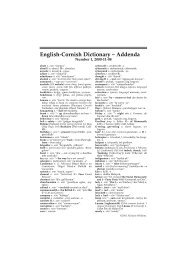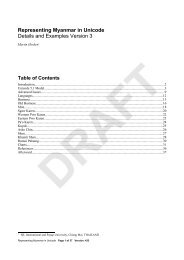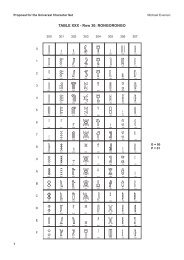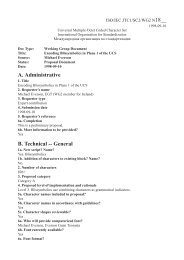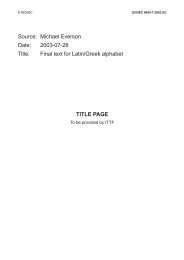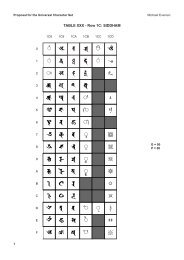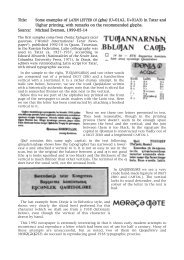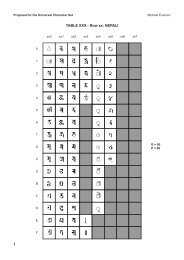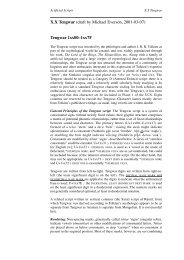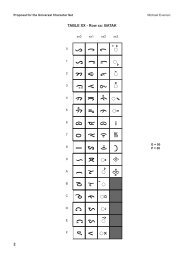ISO/IEC JTC1/SC2/WG2 N3xxx L2/07-xxx - Evertype
ISO/IEC JTC1/SC2/WG2 N3xxx L2/07-xxx - Evertype
ISO/IEC JTC1/SC2/WG2 N3xxx L2/07-xxx - Evertype
Create successful ePaper yourself
Turn your PDF publications into a flip-book with our unique Google optimized e-Paper software.
It can be seen that there are some differences between the order in Figure 1 and Gardiner’s order in<br />
Figure 2, but note that Gardiner’s is not algorithmically derived. For instance, Gardiner orders gbb < Gb<br />
< Gbtñw < gb¨ < gbgb; according to Gardiner’s own alphabetical order one might expect Gb < gb¨ < gbb<br />
< gbgb < Gbtñw (though perhaps Gardiner is using a root-based ordering). Our results gave gb¨ < gbb <<br />
Gb < gbgb < Gbtñw, because the underlying spelling is g-b-(b-¨)-¨-ù < g-b-b-(g-b) < (g-b)-b-ï <<br />
g-b-g-b-ì < g-b-(t-ñ-w)-∫.<br />
Something else that will need to be dealt with is the question of characters with multiple readings.<br />
T019, the harpoon head of bone Ω, has two readings, gn and k. s, and it is uncertain how a decision about<br />
“primary” values will be made. Second- and third-level ordering for homophones like ƒ g and √ g is also<br />
something we have not attempted in this exercise. Nevertheless, it seems clear that a phonetic-based<br />
ordering for Egyptian hieroglyphs yields results which are more useful than binary ordering would yield.<br />
Another way of illustrating this is to choose a set of words each beginning with a different letter of the<br />
Egyptian alphabet and order that according to phonetic value and according to binary order. The use of<br />
binary order apparently transforms Egyptian alphabetical order into r, Æ, d, b, h, ¨, m, w, f, d, ñ, k. , n, sˇ, s/z,<br />
¯ ¯<br />
h, p, t,<br />
h. , k, g, t, y, h. Figure 3 shows the same set of words sorted in binary order. When we consulted<br />
¯<br />
with Egyptologists,<br />
˘<br />
they agreed that this order would not be useful to them.<br />
úó…—… dñ h. r gs<br />
üº° gh. s<br />
®ß gmñ<br />
®ß®ßÕ gmgm<br />
®ß¡ô gmh.<br />
®ß¡«ª gmh. t<br />
®ßÃ~ gmw<br />
≠†ï Gb<br />
≤ƃõ«µ ñwgrt<br />
≤ƒõ«µ ñgrt<br />
≥ grh.<br />
ΩΩ gnwt<br />
Ω∆«¿~ gnwt<br />
Ω«À gnwty<br />
æ grg<br />
√†† Gbb<br />
√†∫ Gbtñw<br />
√√Æ«ò~ ggwt<br />
√√ºÀ∫ Gsy<br />
ƒõ gr<br />
ƒõë gr<br />
ƒõæ grg<br />
ƒõæ grg<br />
ƒõ¡ù grh.<br />
ƒõ¡≥ grh.<br />
ěľ grg<br />
ěľ grg<br />
ƒõ« grt<br />
ƒ†ù¥… gb¨<br />
ƒ††¨ gbb<br />
ƒ†©•ù gb¨<br />
ƒ†ƒ†ì gbgb<br />
ƒ•ö g¨w<br />
ƒ•Ø¬¬¬ g¨wt<br />
ƒ•¬´ g¨w<br />
ƒ•Œ´ g¨w<br />
ƒß« gmt<br />
ƒ∞¢ gf1<br />
ƒ∞∑ö gfn<br />
ƒ∑∞öë gnf<br />
ƒ∑∞öë gnf<br />
ƒ∑∑í gnn<br />
ƒ∑∆Æ«Ω¿∂ gnwt<br />
ƒ∏” gs<br />
ƒº“•π gs¨<br />
ƒºÆœ»»» gsw<br />
ƒ¡ºü£ gh. s<br />
ƒ¡º° gh. s<br />
ƒƒÆÀô ggwy<br />
ƒƒ«§ ggt<br />
ƒ–ø≤ gstñ<br />
œ∏û gs<br />
ϸŔ gs<br />
œ…Æêñ~ gsw<br />
œ…‘ gs-pr<br />
œ…ø≤± gstñ<br />
—… gs<br />
Figure 3. The words in Gardiner’s grammar beginning with ƒ g-, expanded to plain-text strings of<br />
characters and sorting in binary order.<br />
10. The UniKemet database and future expansion of the repertoire. The database containing source<br />
references for the characters encoded has been named the UniKemet database after ø¿¡ Kmt “Egypt”<br />
since we considered a name like UniHieroglyph to be too general (given Anatolian Hieroglyphs, Maya<br />
Hieroglyphs, and Míkmaq Hieroglyphs). This database provides the means for Egyptologists to work<br />
with <strong>ISO</strong>/<strong>IEC</strong> <strong>JTC1</strong>/<strong>SC2</strong>/<strong>WG2</strong> and with the Unicode Consortium to add Egyptian Hieroglyphs to the<br />
standard in future. Its structure is relatively straightforward; it contains the following fields:<br />
13





